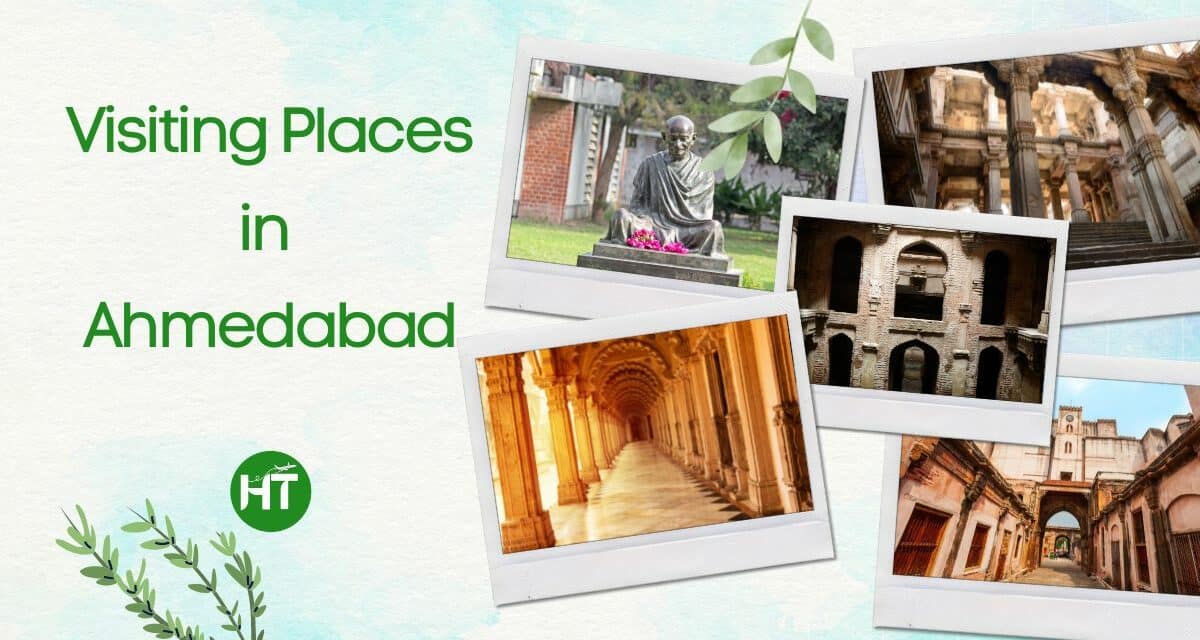If you plan to explore stunning Visiting Places in Ahmedabad,the amazing facts may surprise you. Ahmedabad is the fastest-growing smart city in India.
It is also known as the “Heritage City of India .”Ahmedabad was chosen in honor of the Muzaffarid Dynasty king Ahmad Shah I.
Ahmedabad is the populous city of the western state of Gujrat, India. Sabarmati River passes through the city. Ahmedabad plays a massive part in the Indian Economy and Industries.
India’s Second Largest cotton Industries is located here, so it is called the “Manchester of India” after Kanpur. Now the world’s most enormous Stadium is in Ahmedabad, which gives space for approximately 13,2000 viewers.
Cricket is famous in Ahmedabad, which is why it’s called the Sports city of India. In 2017, UNESCO announced the historic city of Ahmedabad as a World Heritage Site. In the Kalupur area of Ahmedabad, the world’s first Swaminarayan Mandir is situated.
In Indian History, Mahatma Gandhi built two ashrams, the Kochrab Ashram and Satyagharah or Sabarmati Ashram, in this city which was the nucleus of the Indian Independence Movement.
Ahmedabad has a dry and hot semi-arid less rainfall climate. The Kite festival, called Uttarayan, is richly celebrated in Ahmedabad. At the time of Navaratri Garba’s dance will mesmerize you.
Shopping-addicted people will be lost in the markets after seeing the local people’s various handicrafts and mirror works. There are several visiting places in Ahmedabad for every community of people.
Top Visiting Places in Ahmedabad
Ahmedabad is a fantastic place for travelers to investigate. It is a place to explore several heritage buildings, mosques, temples, and step wells. Let’s see the top visiting places in Ahmedabad.
- Bhadra Fort
- Jama Mosque
- Wajihuddin’s Tomb
- Calico Museum of Textiles
- Adalaj Stepwell
- Shree Swaminarayan Mandir Kulpur
- Sabarmati Ashram
Bhadra Fort
Among top visiting places in Ahmedabad, Bhadra Fort is popular. It is a heritage building of Ahmedabad. In 1411, Ahmed Shah I built Bhadra Fort at old Ahmedabad, India.
This mosque is designed as a royal castle with a giant gate and a big lawn. According to Mirat-i-Ahma, di this fort is also known as Arak Fort. Bhadra fort has 8 gates.
Three famous gates are known as “Teen Darwaza,” two small gates in the west, one in the south, and two in the North. Citadel, Azam Khan Sarai, Bhadra Kali Temple, and Clock Tower are some historical innovations of King Ahmed Shah I inside the Bhadra Fort. In 2014 Archaeological Survey India and Ahmedabad Municipal Corporation reconstructed the Bhadra Fort and turned it into Indian Government offices.
- Location: Ahmedabad Court Road, Gujrata India
- Time for entry: 9:00 AM to 5:00 PM every day.
Jama Mosque
In 1424 during the ruling period of Ahmad Shah I, the Jama Mosque of Ahmedabad was constructed. This is the fifth mosque built during Ahmad Shah I.
Jama Mosque is located near the Bhadra Fort. The mosque has large courtyard and prayer halls designed in a Gujrat-style format.
It is notable for looking at the monuments inside the mosque of Mughal emperors.
The roof of the Jama Mosque is supported by 260 columns and has 15 domes. Jama Mosque is one of the most attracted visiting places in Ahmedabad.
- Location: Manek Chowk at Ahmedabad.
- Time for entry: 9:00 AM to 5:00 PM.
Wajihuddin’s Tomb
Wajuhuddin’s Tomb is also called Hazrat Wajihuddin Dargah in Khanpur, Ahmedabad. Syed Murtuza Khan Bukhari built this Tomb in honor of his master Wajihuddin Alvi.
Wajihuddin Alvi was an Islamic scholar who came to Ahmedabad to convey Islamic traditions. The middle dome of the Tomb is the largest among all the tombs of Wajihuddin’s tombs.
The walls and windows are decorated with stones in Indo Islamic architectural style. The exciting part is the underground waterbody of the Tomb never gets dry.
Calico of Textiles Museum
In 1949 Calico Museum of Textiles was established in Ahmedabad, Gujrat. Now, Sarabhai Foundation is the owner of these textiles. It is India’s most enormous Textile Museum in India. Textile museum is one of the popular visiting places in Ahmedabad as well.
Gautam Sarabhai and Gira Sarabhai founded the Calico of Textiles Museum. Museums stored the textiles used by the 15th to 19th century Mughal rulers.
Also, museums have art galleries of various arts hangings, sculptures, crafts, and textiles samples. The National Institute of Design in Ahmedabad is connected and gets services from the Calico of Textiles Museum.
The authorities finely maintain crafts items of the Museum.
- Time for entry: Mon – closed
- Tue to Sat – Mrng 10:00 AM to 12:30 PM; Evng 2:30 PM to 5:30 PM.
Adalaj Stepwell
Stepwells is a construction leading down to the water level, and Gujarati people called it “Vav.” Adalaj Stepwell is also known as a Rudabai Stepwell.
In 1948, Rani Rudadevithe of the Vaghela Dynasty built this Stepwell as a memory of his husband, Rana Veer Singh. Once Upon a time, Adalaj Stepwell provided water for the local people.
This Stepwell was a place for many sacred celebrations at that time. Adalaj Stewell is designed in the Solanki architectural style with Sandstone. It is a five-floor building with a fine architectural structure. Adalaj Stepwell is located near Gandhinagar Station.
- Location: Adalaj, Near Gandhinagar Station, Gujarat.
- Time for entry: 8:00 AM to 6:00 PM.
Shree Swaminarayan Mandir Kulpur
Shree Swami Narayan Mandir is one of the most popular visiting places in Ahmedabad. It was built in the direction of the Hindu sect Swaminarayan Sampraday Kulpur, Ahmedabad.
It was his first temple built on his order in India. Shree Swaminarayan Mandir’s construction was completed on 24 February 1822. The Sampraday of Swaminarayan is divided into two Gadis – 1. Nar Narayan Dev Gadi and 2. Laxmi Narayan Dev Gadi.
The architectural design of the mandir represents the folk cultures, costumes, and religions of Gujarati and Rajasthani. Pillars and windows are built with Burma teaks wood and sculptural art with colorful stones.
Must visit North Gateway, Nar Narayan Temple, Akshar Bhavan, Rang Mahal, Temple for Women, North Haveli, and East Haveli of Kulpur Swaminarayan Mandir.
Every worship deity in the Mandir is Nar Narayan Mandir Dev, Radha Krishna Dev, Dharmabhaktimata and Hari Krushna Maharaj, Bal Swarup Ghanshyam Maharaj, and Ranghmohal Ghanshyam Maharaj.
- Location: Zaveriwad, Kalupur, Ahmedabad Gujrat.
- Aarti Time:
- Mangal Arti – 5:30 AM
- Shangaar Aarti – 6:30 AM
- Rajbhog Aarti – 8:05 AM.
Sabarmati Ashram
In 1915, on 25 May, Mahatma Gandhi established the Sabarmati Ashram in the Kochrab region of Ahmedabad after returning from South Africa. Today Sabarmati Ashram is one of the most popular visiting places in Ahmedabad.
To enjoy the lifestyle of the Village farming, animal husbandry, cow breeding, and khadi forming, Mahatma Gandhi decided to shift the ashram to calm and quiet open land beside the Sabarmati river.
From 1917 to 1930, this ashram was the base of Mahatma Gandhi and other freedom fighters for the Indian freedom satyagraha movement. That’s why this ashram is also known as Satyagraha Ashram.
Now, this ashram carries memories and life stories of Mahatma Gandhi. Sabarmati Ashram gives different platform lessons through their institutions.
- Harijan Ashram Trust: Secondary and Higher education facilities for Harijan girls.
- Gujrat Gramodyog Prayog Samiti: Manage the industries of the village and produce soap, oil, handmade paper, and Khadi.
- Khadi Gramodyog Prayog Samiti: Provides training for renewal resources production.
- Gujrat Harijan Sevak Sangh: Training for Rural Sanitisation and health.
- Ashram Guest House: Training for Servicing tourists.
- Time: 10:00 AM to 5:00 PM.
Conclusion
Ahmedabad is a big city with lots of visiting places. From temples to Heritage buildings, Ahmedabad will have vast Indian historical knowledge. We have listed some visiting places in Ahmedabad in this content. So, take a long holiday and explore Ahmedabad safely.
Which city is called the “Textile hub of India”?
Ahmedabad is the city of Gujrat Western state of India.
Which religion are peoples maximum in Ahmedabad?
Hindu community peoples are maximum in Ahmedabad.
- Which religion are peoples maximum in Ahmedabad?





